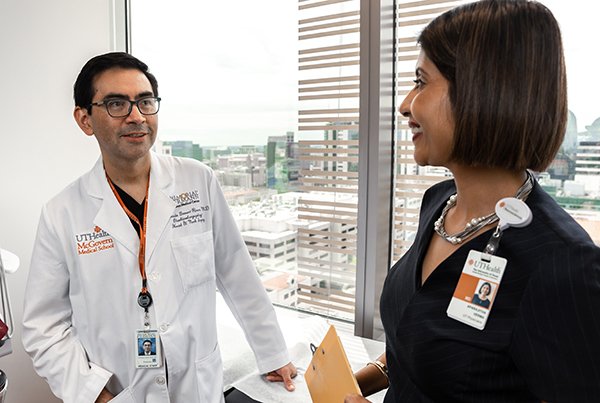Alternative therapy benefits patients with obstructive sleep apnea

Some patients with obstructive sleep apnea (OSA) who don’t respond to traditional therapy are benefiting from an alternative option being offered at UTHealth Houston.
In 2018, UTHealth Houston became the first institution in the city to offer the treatment – an implanted device that stimulates the hypoglossal nerve in patients who have not been able to tolerate continuous positive airway pressure (CPAP) and bi-level positive airway pressure (BiPAP), and who do not have a complete blockage of the upper airway.
It piqued the interest of Charles Njilefack, who was prescribed a CPAP machine 15 years ago but still wasn’t sleeping well.
“I wondered if this was what my life would be like going forward,” said Njilefack, now 61.
After learning more about the alternative therapy, he met with Fernando Gomez-Rivera, MD, an assistant professor in the Department of Otorhinolaryngology-Head and Neck Surgery, who performed an outpatient sleep endoscopy procedure with Njilefack under light sedation, inserting a thin, flexible camera through his nose to localize his upper-airway obstruction. A week after the procedure, Njilefack learned he was a good candidate for the implant, which was created by Inspire Medical Systems and approved by the U.S. Food and Drug Administration.
The procedure, performed in March 2021, involved isolating Njilefack’s hypoglossal nerve and wrapping a stimulator cuff around it. A wire connected the cuff to a central processing unit and generator, which was implanted in the right side of Njilefack’s chest, much like a pacemaker. A pressure sensor was placed in the intercostal muscles between two ribs so that when Njilefack exhales, the movement is detected and the data is sent to the central processing unit. The stimulator receives the information and stimulates the tongue to move forward to keep the airway open.
After the procedure, Gomez referred Njilefack to Aparajitha Verma, MD, MBA, a neurologist and sleep medicine specialist in the Vivian L. Smith Department of Neurosurgery and director of clinical and business development at UTHealth Houston Neurosciences.
“About 50% of people with sleep apnea diagnosed by a sleep study are unable to tolerate CPAP or BiPAP,” Verma said. “These patients have increased risk of heart attack, stroke, high blood pressure, and cognitive issues, as well as risk of car- or work-related accidents due to lack of good sleep.”
Once the device is activated, Verma sees patients four weeks later at a virtual appointment. At six weeks, she sees them in person to check and adjust the settings.
“Each night, the patient turns on the device following my recommendations based on a personalized titration protocol for the settings. Two to three months after the device has been implanted and activated, we do another sleep study while the patient is using the device,” Verma said. “We also follow patients periodically afterwards to ensure that they are getting a good night’s sleep.”
More than one year since receiving the implant, Njilefack says he is sleeping much better.
“The fact that I don’t have to go to sleep with a mask with tubes has won me over,” he said. “So far, it’s working for me.”
Chris Pratt, another of Verma’s patients, used a CPAP for more than two years without any luck. Within six weeks of surgery, Pratt saw Verma in an office visit, where his device was activated. Verma then scheduled Pratt for a second sleep study to check for improvement in his apnea in comparison to his first study.
“The results were good, and during the study my breathing was much better and my sleep apnea was under control,” said Pratt, who is 50. “I had very minimal instances of apnea with the device operating. My work hours vary, and when I’m asleep now, I get optimal sleep, which makes me feel much better.”
Njilefack’s and Pratt’s experiences align with the results of a clinical trial that tested the safety and efficacy of the device, where patients reported a significant reduction in sleep apnea events and significant improvement in quality-of-life measures. The findings were published in a 2014 issue of the New England Journal of Medicine.